Canon 0044C002, 0044C006 User manual
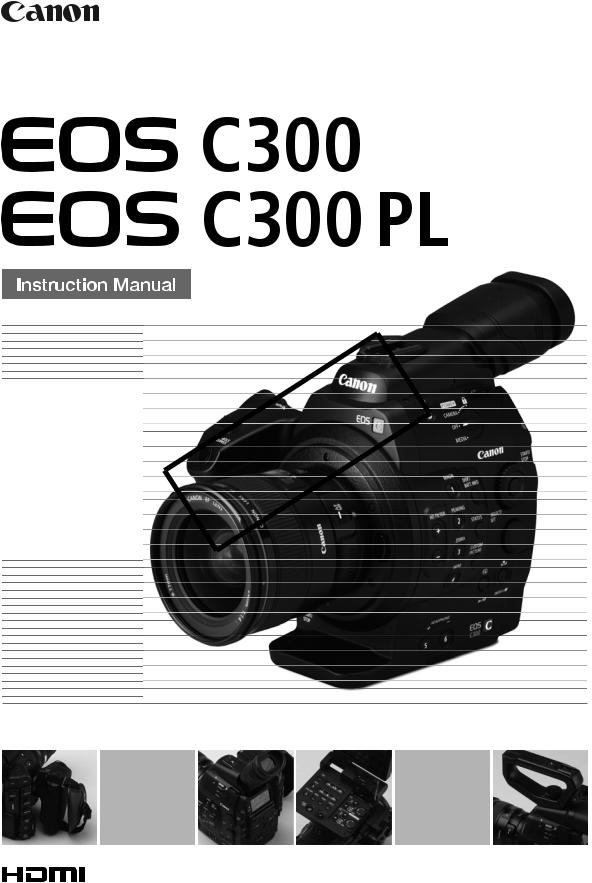
PUB. DIE-0440-001
HD Camcorder
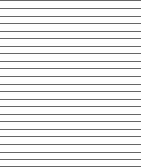 COPY
COPY
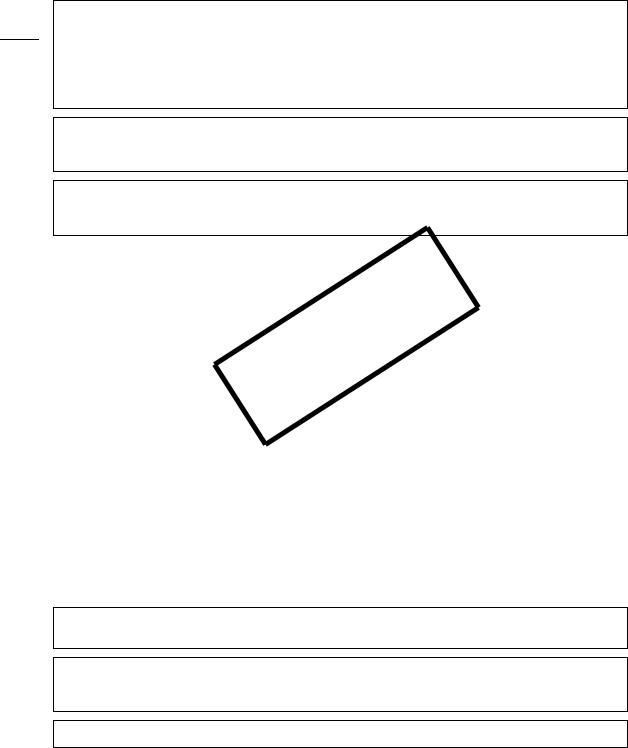
Important Usage Instructions
WARNING
2TO REDUCE THE RISK OF FIRE OR ELECTRIC SHOCK, DO NOT EXPOSE THIS PRODUCT TO RAIN OR MOISTURE.
WARNING
TO REDUCE THE RISK OF ELECTRIC SHOCK, DO NOT EXPOSE THIS PRODUCT TO DRIPPING OR SPLASHING.
WARNING
TO REDUCE THE RISK OF ELECTRIC SHOCK AND TO REDUCE ANNOYING INTERFERENCE, USE THE RECOMMENDED ACCESSORIES ONLY.
COPYRIGHT WARNING:
Unauthorized recording of copyrighted materials may infringe on the rights of copyright owners and be contrary to copyright laws.
FCC NOTICE |
|
|
the equipment off and on, the user is |
|
HD Camcorder, EOS C300 / EOS C300 PL |
encouraged to try to correct the interference by |
|||
Systems. |
|
|
one or more of the following measures: |
|
|
COPY |
|||
This device complies with Part 15 of the FCC |
• Reorient or relocate the receiving antenna. |
|||
Rules. Operation is subject to the following two |
• Increase the separation between the |
|||
conditions: (1) This device may not cause |
equipment and receiver. |
|||
harmful interference, and (2) this device must |
• Connect the equipment into an outlet on a |
|||
accept any interference received, including |
circuit different from that to which the receiver |
|||
interference that may cause undesired |
|
is connected. |
||
operation. |
|
|
||
|
|
• Consult the dealer or an experienced radio/TV |
||
|
|
|
||
Note: This equipment has been tested and |
technician for help. |
|||
found to comply with the limits for class B digital |
Use of shielded cable is required to comply with |
|||
device, pursuant to Part 15 of the F |
Rules. |
|||
class B limits in Subpart B of Part 15 of FCC |
||||
These limits are designed to provide reasonable |
||||
Rules. |
||||
protection against harmful interference in a |
||||
Do not make any changes or modifications to |
||||
residential installation. This equipment |
|
|||
|
the equipment unless otherwise specified in the |
|||
generates, uses and can radiate radio frequency |
||||
manual. |
||||
energy and, if not installed and use in |
|
|||
|
If such changes or modifications should be |
|||
accordance with the instructions, may cause |
||||
made, you could be required to stop operation |
||||
harmful interference to radio communications. |
||||
of the equipment. |
||||
However, there is no guarantee that interference |
||||
|
||||
will not occur in a particular installation. If this |
Canon U.S.A., Inc. |
|||
equipment does cause harmful interference to |
One Canon Park, Melville, NY 11747, USA |
|||
radio or television reception, which can be |
Tel No. 1-800-OK-CANON (1-800-652-2666) |
|||
determined by turning |
|
|
|
|
|
|
|
|
|
The Mains plug is used as the disconnect device. The Mains plug shall remain readily operable to disconnect the plug in case of an accident.
CAUTION:
•Danger of explosion if the wrong type of batteries are attached. Use only the same type of batteries.
•Do not expose batteries or product to excessive heat such as the inside of a car under direct sunlight, fire, etc.
EOS C300 / EOS C300 PL / CA-940N / CG-940 identification plate is located on the bottom.
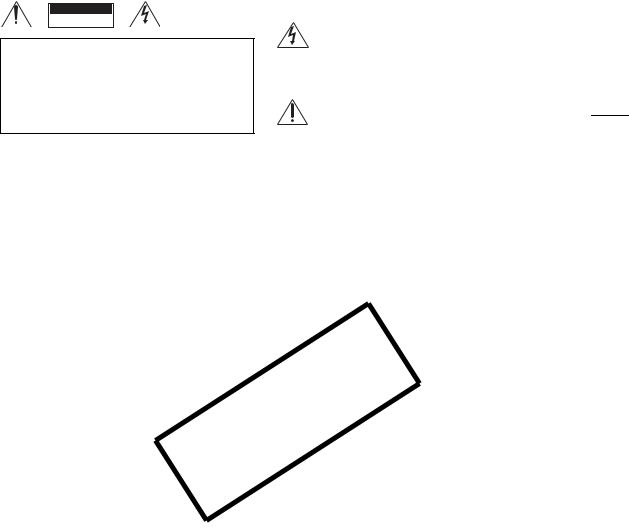
CAUTION
RISK OF ELECTRIC SHOCK
DO NOT OPEN
CAUTION:
TO REDUCE THE RISK OF ELECTRIC SHOCK, DO NOT REMOVE COVER (OR BACK). NO USER-SERVICEABLE PARTS INSIDE. REFER SERVICING TO QUALIFIED SERVICE PERSONNEL.
The lightning flash with arrowhead symbol, within an equilateral triangle, is intended to alert the user to the presence of uninsulated “dangerous voltage” within the product’s enclosure, that may be of sufficient magnitude to constitute a risk of electric shock to persons.
The exclamation point, within an equilateral triangle, is intended to alert the user to the presence of important 3 operating and maintenance (servicing) instructions in
the literature accompanying the product.
COPY
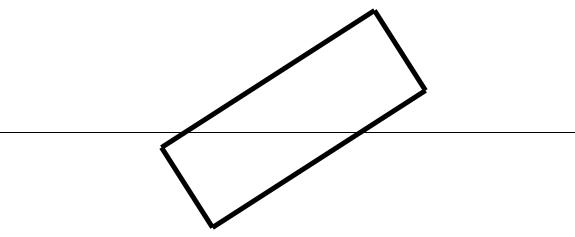
|
|
In these safety instructions the word “apparatus” |
A grounding type plug has two blades and a third |
|
|
4 refers to the Canon HD Camcorder EOS C300 / EOS |
grounding prong. The wide blade or the third |
|
|||
|
|
C300 PL and all its accessories. |
prong are provided for your safety. If the provided |
|
|
|
|
||||
1. |
Read these instructions. |
plug does not fit into your outlet, consult an |
|
||
electrician for replacement of the obsolete outlet. |
|
||||
2. |
Keep these instructions. |
|
|||
10. Protect the power cord from being walked on or |
|
||||
3. |
Heed all warnings. |
|
|||
pinched particularly at plugs, convenience |
|
||||
4. |
Follow all instructions. |
receptacles, and the point where they exit from |
|
||
5. |
Do not use this apparatus near water. |
the apparatus. |
|
||
11. Only use attachments/accessories specified by |
|
||||
6. |
Clean only with dry cloth. |
|
|||
the manufacturer. |
|
||||
7. |
Do not block any ventilation openings. Install in |
|
|||
12. Unplug this apparatus during lightning storms or |
|
||||
|
|
|
accordance with the manufacturer’s instructions. |
|
|
|
|
|
when unused for long periods of time. |
|
|
8. |
Do not install near any heat sources such as |
|
|||
13. Refer all servicing to qualified service personnel. |
|
||||
|
|
|
radiators, heat registers, stoves, or other |
|
|
|
|
|
Servicing is required when the apparatus has |
|
|
|
|
|
apparatus (including amplifiers) that produce |
|
|
|
|
|
been damaged in any way, such as power-supply |
|
|
|
|
|
heat. |
|
|
|
|
|
cord or plug is damaged, liquid has been spilled |
|
|
9. |
Do not defeat the safety purpose of the polarized |
|
|||
or objects have fallen into the apparatus, the |
|
||||
|
|
|
or grounding-type plug. A polarized plug has two |
|
|
|
|
|
apparatus has been exposed to rain or moisture, |
|
|
|
|
|
blades with one wider than the other. |
|
|
|
|
|
does not operate normally, or has been dropped. |
|
|
|
|
|
|
|
|
|
|
|
|
|
|
|
|
|
CAN ICES-3(B)/NMB-3(B) |
|
|
|
|
|
COPY |
|
|
|
|
|
|
||
Trademark Acknowledgements
•SD and SDHC Logos are trademarks of SD-3C, LLC.
•CompactFlash is a trademark of SanDisk Corporation.
•The CF Logo is a trademark of CompactFlash Association.
•Microsoft and Windows are trademarks or registered trademarks of Microsoft Corporation in the United States and/or other countries.
•Apple, Mac OS, Final Cut Pro are trademarks of Apple Inc., registered in the U.S. and other countries.
•Avid, Media Composer and NewsCutter are trademarks or registered trademarks of Avid Technology, Inc. or its subsidiaries in the United States and/or other countries.
•Wi-Fi is a registered trademark of the Wi-Fi Alliance.
•HDMI, the HDMI logo and High-Definition Multimedia Interface are trademarks or registered trademarks of HDMI Licensing LLC in the United States and other countries.
•Other names and products not mentioned above may be trademarks or registered trademarks of their respective companies.
•This device incorporates exFAT technology licensed from Microsoft.
•ANY USE OF THIS PRODUCT OTHER THAN CONSUMER PERSONAL USE IN ANY MANNER THAT COMPLIES WITH THE MPEG-2 STANDARD FOR ENCODING VIDEO INFORMATION FOR PACKAGED MEDIA IS EXPRESSLY PROHIBITED WITHOUT A LICENSE UNDER APPLICABLE PATENTS IN THE MPEG-2 PATENT PORTFOLIO, WHICH LICENSE IS AVAILABLE FROM MPEG LA, L.L.C., 250 STEELE STREET,
SUITE 300, DENVER, COLORADO 80206.
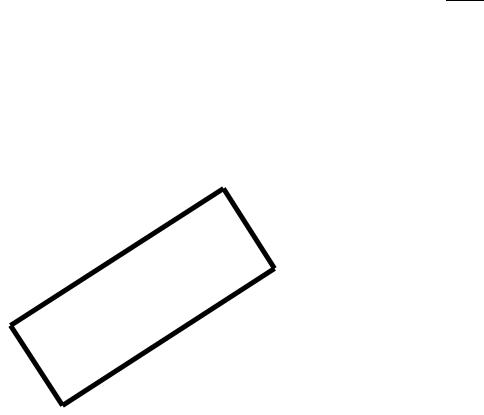
Highlights of the EOS C300/C300 PL
The Canon HD Camcorder EOS C300/C300 PL has been designed to meet the demanding needs and highest expectations of industry professionals. The following are just some of the many features that will help turn your creative vision into reality.
5
HD Recording |
|
Improved displays |
|
Large Super 35mm CMOS sensor and DIGIC DV |
The articulated monitor unit can be rotated 270º, |
||
allowing for easy monitoring and operation from the |
|||
III image processor |
|
||
|
side of the camcorder. When using the viewfinder, its |
||
The camcorder is equipped with a large Super |
|||
improved ergonomic design will ensure a tight and |
|||
35mm CMOS sensor that captures video at an |
|||
comfortable fit. Both the 10.1 cm (4 in.) LCD screen |
|||
effective pixel count of 8.29 megapixels |
|||
and the viewfinder have 100% coverage so you can |
|||
(3840x2160). Combined with the DIGIC DV III image |
|||
always perfectly frame your shots. Additionally, the |
|||
processor, the camcorder offers a center resolution |
|||
rear panel will provide a quick and convenient |
|||
of 1,000 TV lines*. Furthermore, thanks to its fast |
|||
overview of the main shooting functions currently in |
|||
scanning speed, the camcorder produces |
|||
use. |
|||
spectacular video with true-to-life color reproduction |
|||
Recording media |
|||
while reducing noise and “rolling shutter” artifacts. |
|||
* Varies depending on the lens used. |
|
The camcorder records video and audio to |
|
Interchangeable Lenses |
|
CompactFlash (CF) cards. You can even make |
|
Enjoy the freedom and creative versatility of using |
lengthy recordings without worry because the |
||
interchangeable lenses to achieve exactly the look |
camcorder features two CF card slots. When one |
||
you want. The EOS C300 features an EF lens |
CF card becomes full, the recording will |
||
mount, allowing you to use a huge variety of high- |
automatically continue on the other one without |
||
quality Canon EF lenses, including the new high-end |
interruption when you use relay recording (A46). In |
||
Cinema lenses, as well as other lenses. The E S |
addition, using double slot recording (A46) lets |
||
C300 PL features a PL lens mount, allowing you to |
you record the same clip simultaneously to both CF |
||
use a vast array of Super 35mm cinematography |
cards. |
||
lenses commonly used in motion picture production. |
Canon XF Utility software |
||
Superb HD video |
|
Managing your recordings is as simple as using the |
|
The camcorder uses the MPEG-2 Long GOP codec. |
Canon XF Utility software. You can transfer your |
||
|
COPY |
||
Your recordings are saved as Material eXchange |
recordings to your computer, where you can view |
||
Format (MXF) files, which are compatible with major |
and manage them. Using the associated plugins, |
||
non-linear editing (NLE) software. |
|
you can then use the recordings with major NLE |
|
|
|
software*. |
|
Moreover, the camcorder offers you a whole array of options when it comes to the video configuration of your recordings. By controlling the type of recording (NTSC-compatible, PAL-compatible or true 24.00P), bit rate, resolution and frame rate of your recordings you can select a video configuration to suit your needs from a total of 29 different combinations.
Operability and Adaptability
Freely customizable compact design
At its most compact configuration, the camcorder offers convenient and hassle-free hand-held operation. Modular components, including the supplied handle unit, monitor unit and grip unit will let you expand and adapt the configuration to match your shooting conditions (A32).
*Refer to Saving Clips to a Computer (A143) for details on compatible software.
Versatile Artistic Expression
Special recording modes
The special recording modes (A106) give you more creative control over your recordings. You can create a slow motion or fast motion effect in your recordings, record a certain number of frames at a set interval (ideal for nature shots and other subjects with little movement) or record a certain number of frames every time you press a button (ideal for stop motion animation).
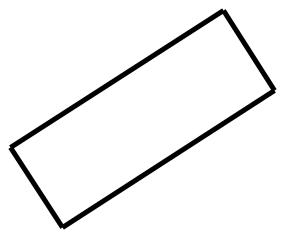
|
Custom picture settings |
|
Other Functions |
|
With custom picture settings (A114), you can enjoy |
#Automatic Functions (AF/AE) |
|
|
unparalleled image control to deliver the “look” you |
With compatible EF lenses, you can automatically |
|
|
want by adjusting parameters, such as gamma and |
||
|
adjust the aperture or focus once with the press of a |
||
|
sharpness. The custom picture settings can be |
||
|
single button (A71, 80) and even use continuous |
||
|
recorded onto an SD card, which allows multiple |
||
|
autofocus (A81), making it easier to support a |
||
|
camcorders to use the same settings, or embedded |
||
|
simple one-person operation. |
||
6 in the recording itself. |
|
||
|
Remote operation via Wi-Fi |
||
|
Canon Log gamma for spectacular dynamic range |
||
|
You can attach the optional WFT-E6 Wireless File |
||
|
You can easily apply the [/CINEMA Locked] preset |
||
|
Transmitter to the camcorder and operate it remotely |
||
|
settings, especially designed with professional |
||
|
via Wi-Fi using the Wi-Fi Remote application (A49). |
||
|
cinematography in mind (A58). Using the Canon |
||
|
The Wi-Fi Remote application lets you monitor the |
||
|
Log gamma, you can get recordings with amazing |
||
|
image through live view and remotely control the |
||
|
dynamic range, allowing you to realize in post- |
||
|
focus, shutter speed, ISO speed/gain and other |
||
|
production the artistic vision you desire. |
||
|
settings. |
||
|
|
|
|
|
|
|
Audio |
|
Advanced Professional Features and |
Sound is recorded as 2-channel linear PCM audio |
|
|
Flexibility |
|
(16-bit/48 kHz). You can use the MIC terminal for |
|
|
microphones with a Ø 3.5 mm mini-stereo plug or the |
|
|
Pro-level connectivity |
|
|
|
|
two XLR audio input terminals (with phantom power |
|
|
An industry-standard HD/SD SDI terminal (A141) |
||
|
supply) when recording. |
||
|
for uncompressed HD signal output, embedded |
||
|
Video scopes |
||
|
audio and SMPTE time code (LTC) give the |
||
|
Check the brightness of the image using the |
||
|
camcorder the functionality of professional broadcast |
||
|
waveform monitor (A99), the color of the image |
||
|
cameras. Genlock synchronization (A88), the TIME |
||
|
using the vectorscope (A100), or the focus using |
||
|
CODE terminal (A89, 90) and SYNC OUT terminal |
||
|
the edge monitor (A100). |
||
|
allow the camcorder to be part of any multi-camera |
||
|
|
||
|
shooting setup. |
|
Added and improved functionality |
|
|
COPY |
|
|
Customization |
|
ther functions include the option to add metadata |
The camcorder features several customization |
(A96) and, using the optional GP-E1 GPS |
|
Receiver, even geotagging data (A103) to your |
||
options. You can assign often-used functions to |
||
recordings, and the Intelligent System-compatible |
||
assignable buttons (A111) so that you can call up |
||
battery pack (A184). |
||
those functions with the press of a single button. You |
||
|
||
can also register frequently-used menu settings in an |
|
|
easy-to-access personal menu (My Menu, A30). |
|
|
Custom functions (A123) and custom onscreen |
|
|
displays (A123) give you even more freedom to |
|
|
control many aspects of the camcorder’s operation. |
|
|
Save custom picture and menu settings to an SD |
|
|
card so that you can transfer your setting preferences |
|
|
to other C300 / C300 PL camcorders in order to use |
|
|
them in the same way. |
|
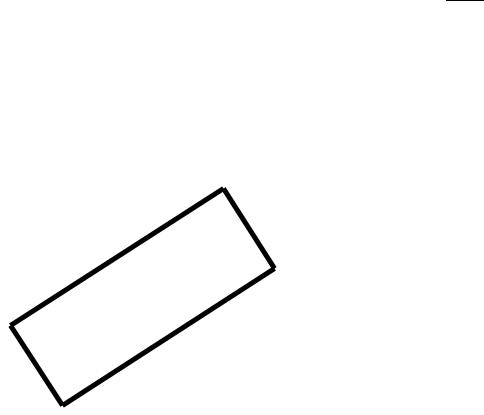
Table of Contents
7
1. Introduction 11 |
|
|
|
|
|
|
|
Adjusting the Black Balance 48 |
|
|||
About this Manual 11 |
|
|
|
|
|
|
|
Operating the Camcorder Remotely 49 |
|
|||
|
|
|
|
|
|
|
Using the RC-V100 Remote Controller |
49 |
||||
Conventions Used in this Manual |
11 |
|
|
|
||||||||
|
|
|
Using the WFT-E6 Wireless File Transmitter 50 |
|||||||||
Supplied Accessories |
13 |
|
|
|
|
|
|
|||||
|
|
|
|
|
|
|
|
|
||||
Names of Parts |
14 |
|
|
|
|
|
|
|
3. Recording 51 |
|
|
|
Monitor Unit |
19 |
|
|
|
|
|
|
|
|
|
||
|
|
|
|
|
|
|
|
|
|
|||
Grip Unit 21 |
|
|
|
|
|
|
|
|
Recording Video 51 |
|
|
|
Handle Unit 21 |
|
|
|
|
|
|
|
Preparing to Record |
51 |
|
||
|
|
|
|
|
|
|
Recording 51 |
|
|
|||
|
|
|
|
|
|
|
|
|
|
|
||
2. Preparations 23 |
|
|
|
|
|
|
|
Remote Operation Using Wi-Fi Remote |
54 |
|||
Preparing the Power Supply |
23 |
|
|
|
|
Onscreen Displays |
55 |
|
||||
|
|
|
|
Rear Panel Displays |
57 |
|
||||||
Using a Battery Pack |
23 |
|
|
|
|
|
|
|
||||
Using a Household Power Outlet |
25 |
|
|
|
Canon Log Gamma and CINEMA Preset 58 |
|||||||
Turning the Camcorder On and Off 26 |
|
|
Video Configuration: Type of Recording, Bit Rate, |
|||||||||
|
|
|
|
|
|
|
|
|
Resolution and Frame Rate 59 |
|
||
|
|
|
|
COPY |
|
|
||||||
Date, Time and Language Settings |
27 |
|
|
Changing Main Camera Functions with the FUNC. |
||||||||
Setting the Date and Time |
27 |
|
|
|
|
|
Button 61 |
|
|
|||
Changing the Time Zone 27 |
|
|
|
|
|
Using the Direct Setting Mode 61 |
|
|||||
Displaying the Date and Time while Recording |
28 |
Shutter Speed 62 |
|
|
||||||||
Changing the Language 28 |
|
|
|
|
|
Changing the Shutter Speed Mode and Value 63 |
||||||
Using the Menus 29 |
|
|
|
|
|
|
|
Remote Operation Using Wi-Fi Remote |
63 |
|||
Selecting an Option from the Menu 29 |
|
|
||||||||||
|
|
Flicker Reduction 64 |
|
|||||||||
Using the Customized Submenu (My Menu) |
30 |
|
||||||||||
ISO Speed/Gain 65 |
|
|
||||||||||
Preparing the Camcorder 32 |
|
|
|
|
|
|
|
|||||
|
|
|
|
|
Changing the ISO Speed or Gain Value |
65 |
||||||
Preparing the Lens 32 |
|
|
|
|
|
|
||||||
|
|
|
|
|
|
Using the Control Dial 66 |
|
|||||
Attaching and Removing the Monitor Unit |
36 |
|
||||||||||
Remote Operation Using Wi-Fi Remote |
67 |
|||||||||||
Using the Viewfinder |
37 |
|
|
|
|
|
|
|||||
|
|
|
|
|
|
ND Filter 68 |
|
|
||||
Using the LCD Panel |
38 |
|
|
|
|
|
|
|
|
|||
|
|
|
|
|
|
Using the ND Filter |
68 |
|
||||
Adjusting the Viewfinder/LCD Screen |
39 |
|
|
|
||||||||
|
|
Remote Operation Using Wi-Fi Remote |
68 |
|||||||||
Using a Tripod 40 |
|
|
|
|
|
|
|
|||||
|
|
|
|
|
|
|
#Adjusting the Aperture 69 |
|
||||
Removing and Attaching the Grip Unit |
40 |
|
|
|
||||||||
|
|
Manual Aperture 69 |
|
|||||||||
Attaching the Handle Unit |
41 |
|
|
|
|
|
|
|||||
|
|
|
|
|
Momentary Automatic Aperture - Push Auto |
|||||||
Attaching a Shoulder Strap |
41 |
|
|
|
|
|||||||
|
|
|
|
Iris 71 |
|
|
||||||
Removing and Attaching the Terminal Covers |
42 |
|
|
|||||||||
Automatic Aperture |
72 |
|
||||||||||
Preparing Recording Media |
43 |
|
|
|
|
|
|
|||||
|
|
|
|
|
Exposure Compensation - AE Shift 72 |
|
||||||
Inserting a CF Card |
43 |
|
|
|
|
|
|
|
||||
|
|
|
|
|
|
Light Metering Mode 73 |
|
|||||
Checking the Status of the CF Card Slots |
43 |
|
||||||||||
White Balance 74 |
|
|
||||||||||
Removing a CF card |
44 |
|
|
|
|
|
|
|
|
|||
|
|
|
|
|
|
Setting the White Balance 74 |
|
|||||
Inserting and Removing an SD Card |
44 |
|
|
|
||||||||
|
|
Remote Operation Using Wi-Fi Remote |
75 |
|||||||||
Initializing the Recording Media 45 |
|
|
|
|||||||||
|
|
|
Adjusting the Focus |
77 |
|
|||||||
Switching Between the CF Card Slots |
45 |
|
|
|
||||||||
|
|
Manual Focus 77 |
|
|
||||||||
Selecting the CF Card Recording Method |
46 |
|
|
|||||||||
#One-Shot AF |
80 |
|
||||||||||
Checking the Available Recording Time for CF |
|
|||||||||||
#Continuous AF 81 |
|
|||||||||||
Cards 47 |
|
|
|
|
|
|
|
|
||||
|
|
|
|
|
|
|
|
|
|
|||
Recovering Data on the CF Card |
47 |
|
|
|
|
|
|
|||||
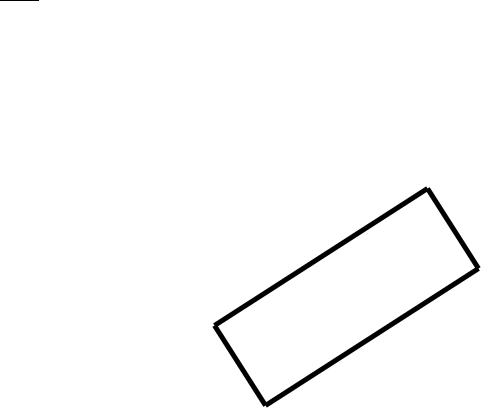
8
Onscreen Markers and Zebra Patterns |
82 |
Recording GPS Information (Geotagging) |
103 |
||||||
Displaying Onscreen Markers |
82 |
|
|
Reviewing a Recording 105 |
|
|
|||
Displaying Zebra Patterns 83 |
|
|
|
Special Recording Modes |
106 |
|
|
||
Setting the Time Code 84 |
|
|
|
Interval Recording Mode |
106 |
|
|
||
Selecting the Running Mode |
84 |
|
|
Frame Recording Mode |
107 |
|
|
||
Selecting Drop or Non-Drop Frame |
85 |
Slow & Fast Motion Mode 108 |
|
|
|||||
Putting the Time Code Display on Hold |
86 |
Pre-recording Mode 110 |
|
|
|||||
Setting the User Bit 87 |
|
|
|
|
4. Customization 111 |
|
|
|
|
Synchronizing with an External Device |
88 |
|
|
|
|||||
Connecting an External Device 88 |
|
|
Assignable Buttons |
111 |
|
|
|
||
Reference Video Signal Input (Genlock |
|
Changing the Assigned Function |
111 |
|
|||||
Synchronization) |
88 |
|
|
|
Using an Assignable Button 112 |
|
|||
Time Code Signal Input |
89 |
|
|
|
Custom Picture Settings |
114 |
|
|
|
Reference Video Signal Output 90 |
|
|
Selecting Custom Picture Files 114 |
|
|||||
Time Code Signal Output 90 |
|
|
|
Editing a Custom Picture File’s Settings |
115 |
||||
Recording Audio 91 |
|
|
|
|
Renaming Custom Picture Files |
115 |
|
||
Connecting an External Microphone or External |
rotecting Custom Picture Files |
116 |
|
||||||
Audio Input Source to the Camcorder 91 |
Transferring Custom Picture Files |
116 |
|
||||||
Selecting the Audio Input from the XLR |
|
Embedding Custom Picture Settings in a |
|
||||||
Terminals 92 |
|
|
|
|
Recording 117 |
|
|
|
|
Adjusting the Audio Level from the XLR |
|
Available Custom Picture Settings 117 |
|
||||||
Terminals 93 |
|
|
|
|
Customizing Functions and Onscreen |
|
|||
Adjusting the Audio Level from the MIC |
|
|
|||||||
|
Displays 123 |
|
|
|
|||||
Terminal 94 |
|
|
|
|
Customizing Functions |
123 |
|
|
|
Monitoring the Audio with Headphones |
95 |
|
|
|
123 |
|
|||
|
|
COPYCustomizing Onscreen Displays |
|
||||||
Selecting the Audio Channel |
95 |
|
|
Saving and Loading Camera Settings 124 |
|||||
Using Metadata 96 |
|
|
|
|
Saving Camera Settings to an SD Card |
124 |
|||
Setting a User Memo Created with Canon XF |
Loading Camera Settings from an SD Card 124 |
||||||||
Utility 96 |
|
|
|
|
|
|
|
|
|
Setting a User Memo Using Wi-Fi Remote 97 |
5. Playback 125 |
|
|
|
|
||||
Colors Bars/Audio Reference Signal |
98 |
Playback 125 |
|
|
|
|
|||
Recording Color Bars |
98 |
|
|
|
Clip Index Screen |
125 |
|
|
|
Recording an Audio Reference Signal |
98 |
Playing Back Clips |
127 |
|
|
|
|||
Video Scopes 99 |
|
|
|
|
Onscreen Displays |
128 |
|
|
|
Displaying a Video Scope 99 |
|
|
|
Playback Controls |
129 |
|
|
|
|
Configuring the Waveform Monitor |
99 |
|
Adjusting the Volume 129 |
|
|
||||
Configuring the Vectorscope |
100 |
|
|
|
|
|
|
|
|
Configuring the Edge Monitor |
100 |
|
|
|
|
|
|
|
|
Adding Marks while Recording |
101 |
|
|
|
|
|
|
|
|
Adding Shot Marks while Recording |
101 |
|
|
|
|
|
|||
Remote Operation Using Wi-Fi Remote |
101 |
|
|
|
|
|
|||
Adding an $Mark or %Mark to the Last Clip |
|
|
|
|
|
||||
Recorded 102 |
|
|
|
|
|
|
|
|
|
Remote Operation Using Wi-Fi Remote |
102 |
|
|
|
|
|
|||

9
Clip Operations |
130 |
|
|
|
|
|
Photo Operations 150 |
|
|
Using the Clip Menu |
131 |
|
|
|
|
Using the Photo Menu 150 |
|
||
Displaying Clip Information |
131 |
|
|
Deleting Photos 150 |
|
||||
Adding $Marks or %Marks |
132 |
|
Protecting Photos 151 |
|
|||||
Deleting $Marks or %Marks |
133 |
|
Copying Custom Picture Files |
152 |
|||||
Copying Clips |
133 |
|
|
|
|
|
Photo Numbering 153 |
|
|
Deleting Clips |
134 |
|
|
|
|
|
8. Additional Information 155 |
||
Deleting the User Memo and GPS |
|
|
|||||||
Information 134 |
|
|
|
|
Menu Options 155 |
|
|
||
Copying a Custom Picture File Embedded in a |
Displaying the Status Screens |
165 |
|||||||
Clip 135 |
|
|
|
|
|
|
Troubleshooting 172 |
|
|
Displaying an Index Screen of Shot Marks |
135 |
List of Messages 175 |
|
||||||
Displaying a Frame Index Screen of a Single |
Handling Precautions |
178 |
|
||||||
Clip 136 |
|
|
|
|
|
|
Maintenance/Others |
181 |
|
Adding Shot Marks |
137 |
|
|
|
|
Optional Accessories |
183 |
|
|
Deleting Shot Marks |
137 |
|
|
|
|
Specifications 187 |
|
|
|
Changing a Clip’s Thumbnail 138 |
|
|
Index 191 |
|
|
||||
6. External Connections 139 |
|
|
|
|
|
|
|||
Video Output Configuration |
139 |
|
|
|
|
|
|||
Video Output Configuration by Terminal 139 |
|
|
|
||||||
Connecting to an External Monitor |
140 |
|
|
|
|
||||
Connection Diagram |
140 |
|
|
|
|
|
|
|
|
Using the HD/SD SDI Terminal |
141 |
|
|
|
|
||||
Using the HDMI OUT Terminal |
COPY141 |
|
|
||||||
Using the SYNC OUT Terminal |
141 |
|
|
|
|
||||
SD Output 142 |
|
|
|
|
|
|
|
|
|
Superimposing Onscreen Displays to Appear on |
|
|
|
||||||
an External Monitor 142 |
|
|
|
|
|
|
|||
Saving Clips to a Computer |
143 |
|
|
|
|
|
|||
Saving MXF Clips 143 |
|
|
|
|
|
|
|
||
Installing Canon XF Utility (Windows) 143 |
|
|
|
|
|||||
Installing Canon XF Utility (Mac OS) |
144 |
|
|
|
|
||||
Viewing the Software Instruction Manuals |
146 |
|
|
|
|||||
7. Photos 147 |
|
|
|
|
|
|
|
|
|
Taking Photos 147 |
|
|
|
|
|
|
|
|
|
Taking Photos in CAMERA Mode |
147 |
|
|
|
|
||||
Capturing Photos in MEDIA Mode |
147 |
|
|
|
|
||||
Photo Playback |
149 |
|
|
|
|
|
|
|
|
Displaying the [Photos] Index Screen 149 |
|
|
|
|
|||||
Viewing Photos |
149 |
|
|
|
|
|
|
|
|
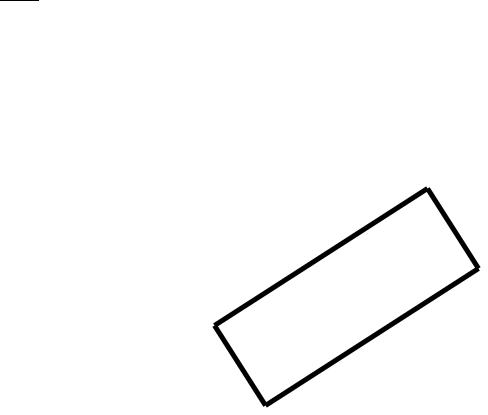
10
COPY
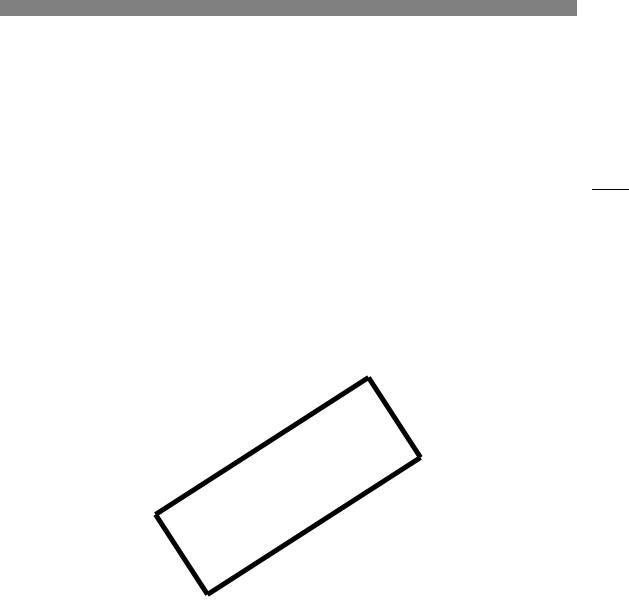
1 |
Introduction |
|
11
About this Manual
Thank you for purchasing the Canon EOS C300/C300 PL. Please read this manual carefully before you use the camcorder and retain it for future reference. Should the camcorder fail to operate correctly, refer to
Troubleshooting (A172).
Conventions Used in this Manual
• IMPORTANT: Precautions related to the camcorder’s operation.
IMPORTANT: Precautions related to the camcorder’s operation.
• NOTES: Additional topics that complement the basic operating procedures.
NOTES: Additional topics that complement the basic operating procedures.
•A: Reference page number.
•#: Text that applies only to the model shown in the icon.
•The following terms are used in this manual.
“Screen” refers to the LCD screen and the viewfinder screen. “CF card” refers to a CompactFlashCOPY(CF) card.
“SD card” refers to an SD or SDHC memory card. “Recording media” refers to CF cards and SD cards.
•Photographs in the manual are simulated pictures taken with a still camera. Some screenshots have been altered to make them easier to read.
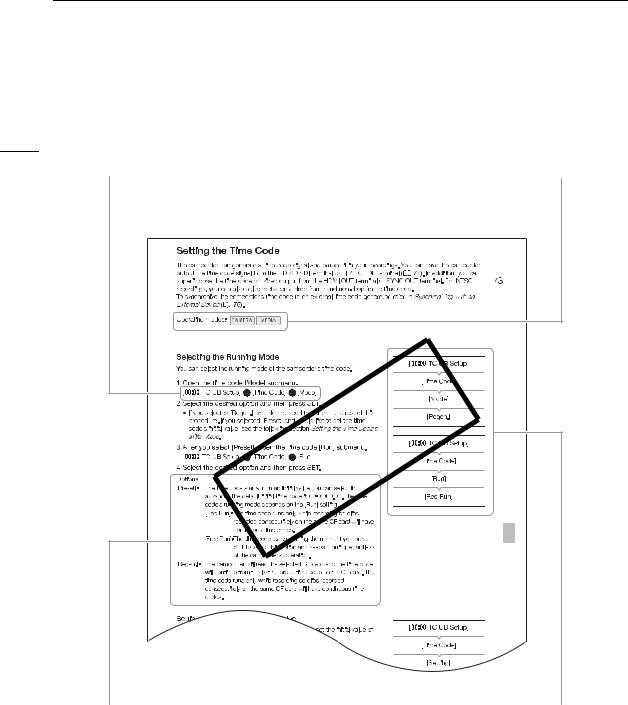
About this Manual
The arrow is used to abbreviate menu selections. For a detailed explanation on how to use the menus, refer to Using the Menus
12(A29). For a concise summary of all available menu options and settings, refer to the appendix
Menu Options (A155).
Operating modes
 indicates that a function is available in the operating mode indicated and
indicates that a function is available in the operating mode indicated and  indicates that the function is not available. For a detailed explanation, refer to Turning the Camcorder On and Off (A26).
indicates that the function is not available. For a detailed explanation, refer to Turning the Camcorder On and Off (A26).
COPY |
When a procedure requires selecting an option, the available options are listed within or after the procedure. Brackets [ ] are used to refer to menu options as they are displayed on screen.
When a function requires the use of the menu, the quick reference shows the submenus and, when applicable, the default setting for the menu item. The example illustration indicates that you can find the function by selecting the
[¤TC/UB Setup] menu and then the [Time Code] menu item.
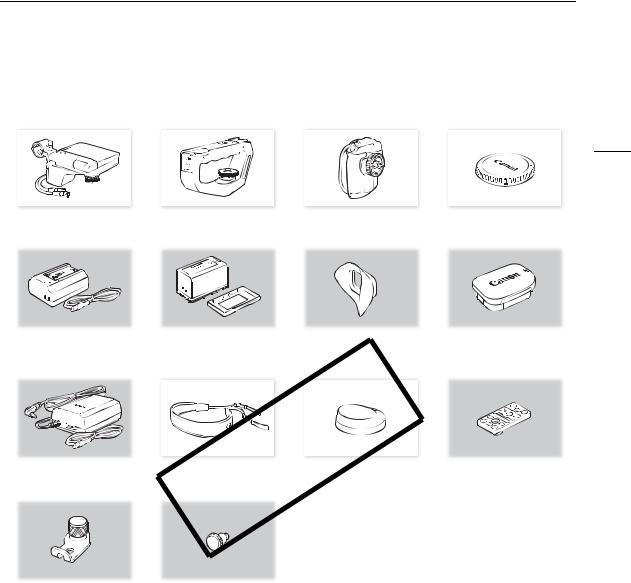
Supplied Accessories
Supplied Accessories
The following accessories are supplied with the camcorder.
13
Monitor Unit |
|
Handle Unit |
|
Grip Unit1 |
|
Body Cap1 |
|
|
|
|
|
|
|
|
|
|
|
|
|
|
Battery Charger CG-940 |
BP-955 Battery Pack |
Eye Cup |
Viewfinder Cap |
(incl. power cord) |
(incl. terminal cover) |
|
|
|
|
|
COPY |
|
|
||
CA-940N Compact Power Adapter |
Adapter Base for 0.64 cm (1/4 in.) |
||||||
SS-1200 Shoulder Strap |
Thumb Rest |
||||||
|
(incl. power cord) |
|
|
|
Tripods |
||
|
|
|
|
|
|
||
|
|
|
|
|
|
|
|
|
WFT Attachment Bracket2 |
Tape Measure Hooks1 (x 2) |
|
|
|
||
1 Comes pre-attached to the camcorder.
2 Used to secure the optional WFT-E6 Wireless File Transmitter or optional GP-E1 GPS Receiver, when it is attached to the camcorder.
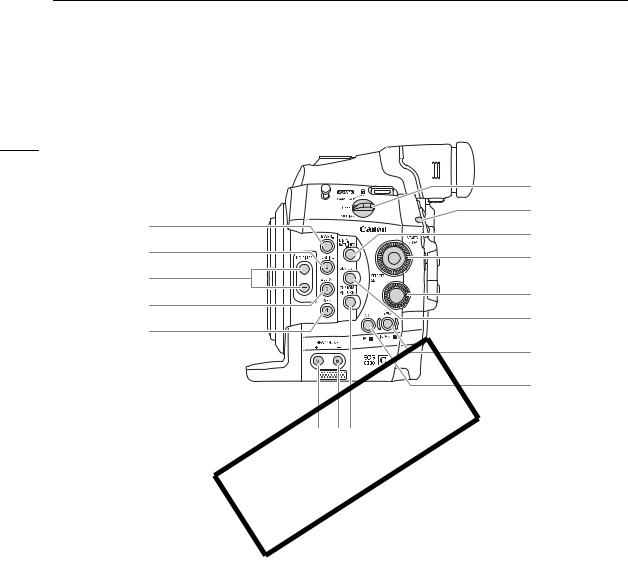
Names of Parts
Names of Parts
14
|
6 |
|
1 |
7 |
|
8 |
||
2 |
||
9 |
||
|
||
3 |
10 |
|
4 |
||
11 |
||
5 |
||
|
||
|
12 |
|
|
13 |
|
|
COPY |
||
|
|
|
14 15 16 |
|
1 |
MAGN. (magnification) button (A79)/ |
10 |
Control dial (A66, 69) |
|
|
Assignable button 1 (A111) |
|
11 |
STATUS button (A165) |
2 |
PEAKING button (A79) / |
|
12 |
Å(white balance adjustment) button (A74)/ |
|
Assignable button 2 (A111) |
|
|
INDEX button (A126)/Ñ(stop) button (A127) |
3 |
ND FILTER +/- buttons (A68) |
13 |
u(review recording) button (A105)/Ò |
|
4 |
ZEBRA button (A83)/ |
|
|
(play/pause) button (A127) |
|
Assignable button 3 (A111) |
|
14 |
HEADPHONE + button (A129)/Assignable |
5 |
WFM (waveform monitor) button (A99)/ |
|
button 5 (A111) |
|
|
Assignable button 4 (A111) |
|
15 |
HEADPHONE - button (A129)/Assignable |
6 |
Qswitch (A26) |
|
|
button 6 (A111) |
7 |
Tally lamp (A51) |
|
16 |
CUSTOM PICTURE button (A114) |
8DISP. (display) button (A55,128)/BATT. INFO (battery information) button (A24)
9SELECT dial/SET button (A29)
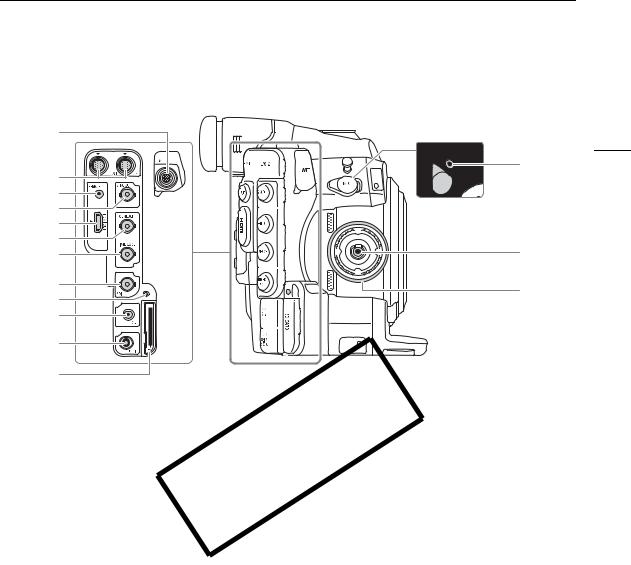
Names of Parts
17
18
19
20
21
22
23
24
25
26
27
28
17 |
WFT terminal (A |
49, 103) |
COPY |
||
|
24 |
HD/SD SDI terminal (A141) |
|||
18 |
EXT (external signal) terminals 1 and 2 (A36) |
25 |
SD card access indicator (A44) |
||
19 |
REMOTE terminal |
|
|
26 |
×(headphone) terminal (A95) |
|
For connecting commercially available remote |
27 |
DC IN terminal (A25) |
||
|
controllers. |
|
|
28 |
SD card slot (A44) |
20 |
SYNC OUT (synchronizing signal output) terminal |
29 |
MIC (microphone) terminal (A91) |
||
|
(A90,141) |
|
|
30 |
Grip Unit connection terminal (A40) |
21 |
HDMI OUT terminal (A141) |
|
31 |
Grip Unit attachment thread (A40) |
|
22 |
GENLOCK terminal (A88) |
|
|
|
|
23 |
TIME CODE terminal (A89, 90) |
|
|
||
15
29
30
31
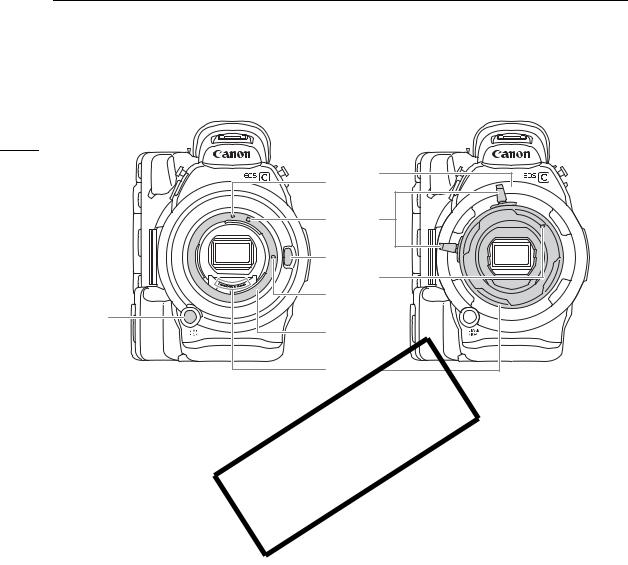
Names of Parts
#$
16
|
|
33 |
39 |
|
|
|
|
|
|
|
|
|
|
34 |
40 |
|
|
|
|
35 |
41 |
|
|
|
|
|
|
||
|
|
36 |
|
|
|
|
32 |
37 |
|
|
|
|
|
|
|
|
|
|
|
38 |
42 |
|
|
32 |
START/STOP button (A51) |
COPY |
|||
|
39 |
$ |
L Lens mount (A36) |
||
33 |
#EF Lens mount index (A32) |
40 |
$Bayonet ring handles (A36) |
||
34 |
#EF-S Lens mount index (A32) |
41 |
$PL Lens index pin (A36) |
||
35 |
#Lens release button (A32) |
42 |
$Bayonet ring (A36) |
||
36 |
#EF Lens lock pin (A32) |
|
|
|
|
37 |
#EF Lens mount (A32) |
|
|
|
|
38 |
#EF Lens contacts (A32) |
|
|
|
|
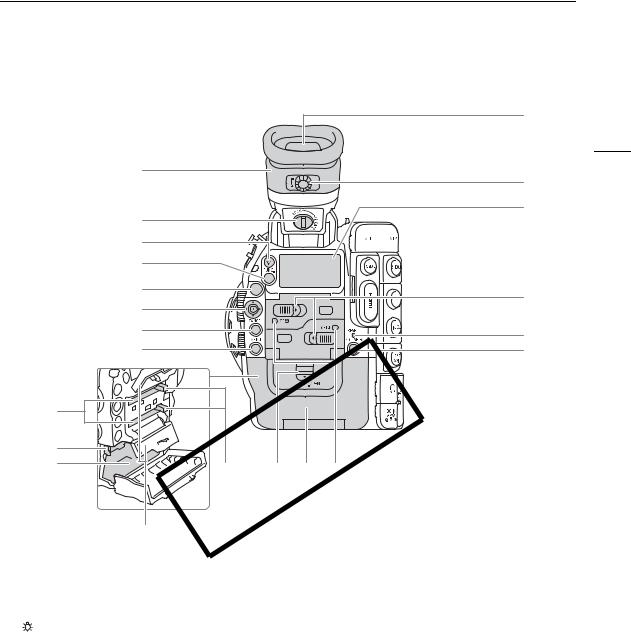
Names of Parts
51
52
53
43
44
45
46
47
48
49
50
COPY |
|||
61 |
62 |
63 |
64 |
60
54
17
55
56
57
58
59
43 |
Viewfinder unit |
57 |
CF card slot cover switches for CF card slots A |
44 |
Viewfinder unit LOCK/RELEASE screw (A181) |
|
(top) and B (bottom) (A43) |
45 |
(rear panel’s backlight) button (A57) |
58 |
RESET button (A174) |
46 |
FUNC. (main functions) button (A61) |
59 |
SLOT SELECT (CF card slot selection) button |
47 |
START/STOP button (A51) |
|
(A45, 126) |
48 |
Joystick (A29)/SET button (A29) |
60 |
CF card slot covers for CF card slots A (top) and B |
49 |
CANCEL button (A29) |
|
(bottom) |
50 |
MENU button (A29) |
61 |
CF card release buttons for CF card slots A (top) |
51 |
CF card slots A (top) and B (bottom) (A43) |
|
and B (bottom) (A44) |
52 |
RELEASE (battery release) latch (A24) |
62 |
BATT. OPEN (open battery compartment) switch |
53 |
Battery compartment (A24) |
|
(A24) |
54 |
Viewfinder (A37, 39) |
63 |
Battery compartment cover (A24) |
55 |
Dioptric adjustment dial (A38) |
64 |
CF2(CF card slot A) and CF3(CF card slot B) |
56 |
Rear panel (A57) |
|
access indicators (A43) |
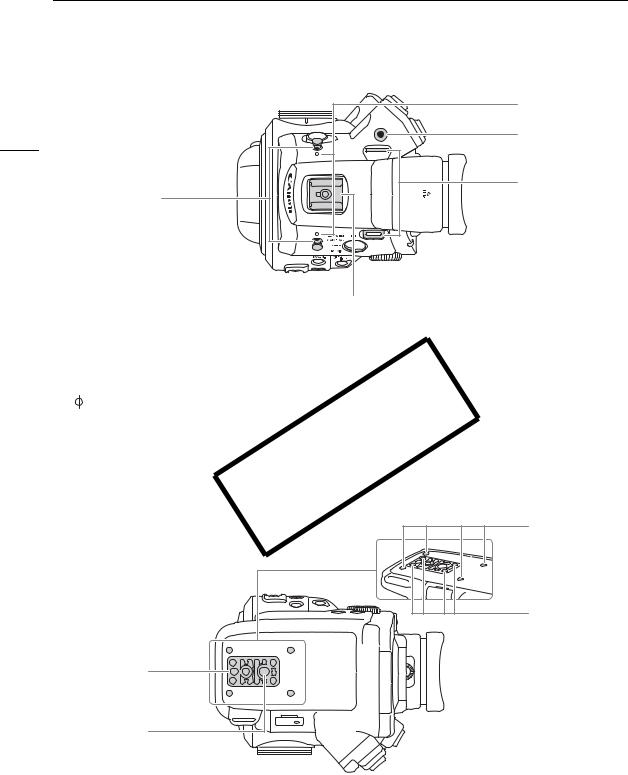
Names of Parts
|
66 |
18 |
67 |
|
68 |
|
65 |
|
|
|
69 |
|
65 |
Tape measure hooks |
|
69 Accessory shoe with mounting hole for |
|
|
Use the hooks to accurately measure the distance |
0.64 cm (1/4 in.) screws |
|
|
|
from the focal plane. |
|
For attaching accessories such as the optional |
|
66 |
Focal plane marks |
COPY |
|
|
|
VL-10Li II Battery Video Light. |
|
||
67 |
Socket for the WFT Attachment Bracket (A49) |
|
|
|
68 |
Strap mounts (A41) |
|
|
|
|
|
|
|
72 |
73 |
70
71
70 |
TB-1 Tripod Base for tripods with 0.95 cm (3/8 in.) |
72 |
Attachment sockets for the optional TA-100 Tripod |
|
screws (A40) |
|
Adapter (A40) |
71 |
Tripod socket (A40) |
73 |
Tripod base screws (A40) |
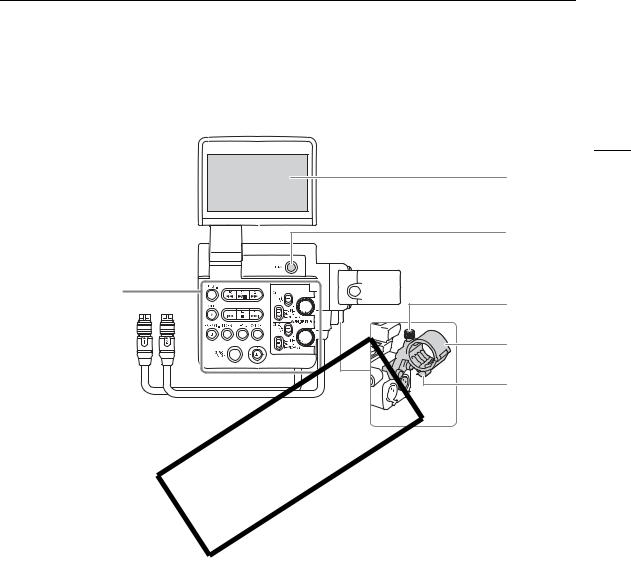
Names of Parts
Monitor Unit
Operation panel
(A20)
COPY

1LCD panel
2MIRROR button (A38)
3 Microphone lock screw (A91)
4Microphone holder (A91)
5Microphone cable clamp (A91)
6XLR terminals CH1 (right) and CH2 (left) (A91)
19
1
2
3
4
5
6
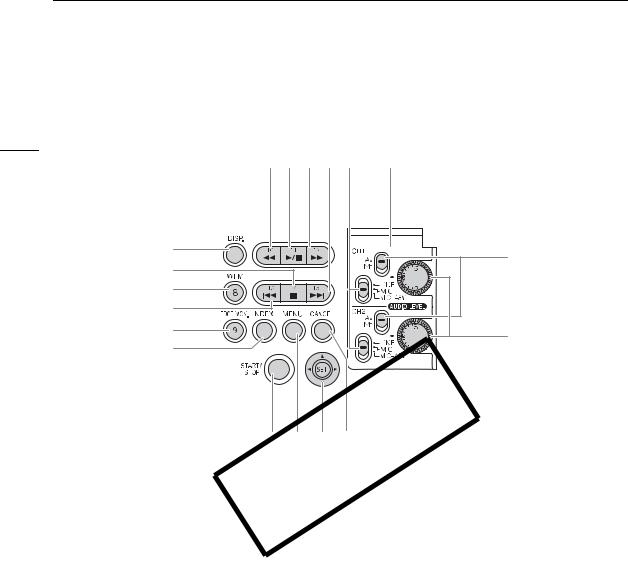
Names of Parts
Operation panel
20
13 14 15 16 |
17 |
18 |
7 |
19 |
|
8 |
||
|
||
9 |
|
|
10 |
|
|
11 |
20 |
|
12 |
||
|
|
|
COPY |
||||
|
|
21 |
22 |
23 |
24 |
|
7 |
DISP. (display) button (A55, 128) |
|
|
16 |
Ù(skip forward) button (A129)/ |
|
8 |
Ñ(stop) button (A127)/ |
|
|
|
|
Assignable button 15 (A111) |
|
Assignable button 14 (A111) |
|
|
|
17 |
XLR terminal switches for CH1 (top) and CH2 |
9 |
WFM (waveform monitor) button (A99)/ |
|
|
|
(bottom) (A92) |
|
|
Assignable button 8 (A111) |
|
|
|
18 |
Protective cover for XLR audio controls (A93) |
10 |
Ú(skip backward) button (A129)/ |
|
|
19 |
ãswitches for CH1 (top) and CH2 |
|
|
Assignable button 13 (A111) |
|
|
|
|
(bottom) (A93) |
11 |
EDGE MON. (edge monitor) button (A99)/ |
|
20 |
ãdials for CH1 (top) and CH2 (bottom) |
||
|
Assignable button 9 (A111) |
|
|
|
|
(A93) |
12 |
INDEX button (A126) |
|
|
|
21 |
START/STOP button (A51) |
13 |
Ø(fast reverse playback) button (A129)/ |
|
22 |
MENU button (A29) |
||
|
Assignable button 10 (A111) |
|
|
|
23 |
Joystick (A29)/SET button (A29) |
14 |
Ò(play/pause) button (A127)/ |
|
|
24 |
CANCEL button (A29) |
|
|
Assignable button 11 (A111) |
|
|
|
|
|
15×(fast playback) button (A129)/ Assignable button 12 (A111)

Names of Parts
Grip Unit
1 |
|
|
|
5 |
21 |
|
|
|
|
2
3
4 |
6 |
|
|
|
7 |
1MAGN. (magnification) button
Assignable button 7 (A111)
2Control dial (A66, 69)
3START/STOP button (A51)
Handle Unit
COPY |
||
(A79)/ |
4 |
Grip belt (A41) |
|
5 |
Joystick (A29)/SET button (A29) |
|
6 |
Connection plug (A40) |
|
7 |
Lock screw (A40) |
1 |
|
|
|
3 |
|
|
|
||
|
|
|
|
|
|
|
|
|
|
2
4
1 |
Mounting hole for 0.64 cm (1/4 in.) screws |
3 |
Top accessory shoe |
2 |
Front accessory shoe |
4 |
Lock screw (A41) |

Names of Parts
22
COPY
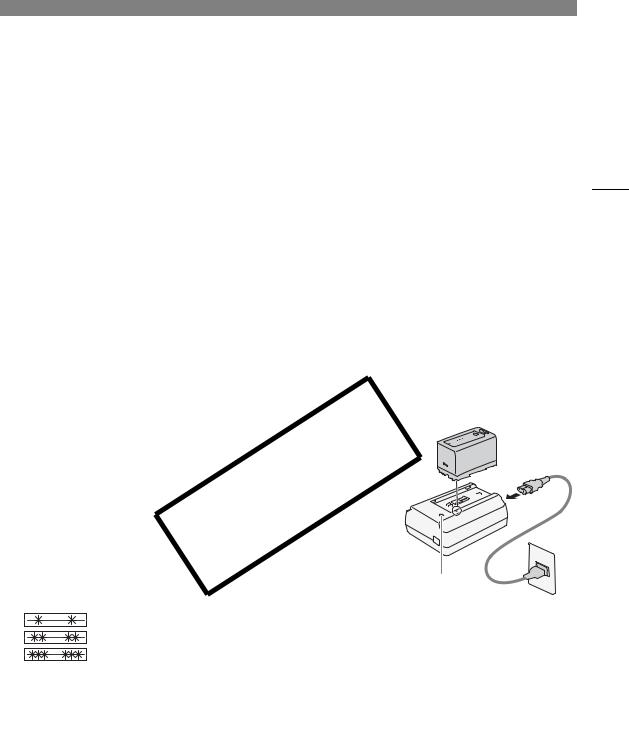
2 |
Preparations |
|
23
Preparing the Power Supply
You can power the camcorder using a battery pack or directly using the compact power adapter. If you connect the compact power adapter to the camcorder while a battery pack is attached, the camcorder will draw power from the power outlet.
Charge battery packs before use. For approximate charging times and recording/playback times with a fully charged battery pack, refer to Charging Times (A184) and Recording and Playback Times (A184).
Using a Battery Pack
You can power the camcorder using the supplied BP-955 or an optional BP-950G, BP-970G or BP-975 Battery Pack*. All four are compatible with Intelligent System, meaning that you can check the remaining battery time.
*The optional BP-970G / BP-975 Battery Pack was not originally designed for use with this camcorder. Because of its size, you will not be able to close the battery compartment cover when using one (A179).
Charging the Battery Pack |
COPY |
|
Charge battery packs using the supplied CG-940 Battery Charger. Before charging, remove the terminal cover of the battery pack.
1 Connect the power cord to the battery charger.
2 Plug the power cord into a power outlet.
3 Attach the battery pack to the battery charger.
• Press lightly and slide the battery pack in the direction of the arrow until it clicks.
• The CHARGE indicator starts flashing and also indicates the battery pack’s approximate charge. The indicator will stay on when charging has completed.
0-34%: Flashes once per second
35-69%: Flashes twice per second
70-99%: Flashes 3 times per second

CHARGE indicator
4 When charging has completed, remove the battery pack from the battery charger.
5 Unplug the power cord from the power outlet and disconnect it from the battery charger.
 IMPORTANT
IMPORTANT
• Do not connect to the battery charger any product that is not expressly recommended for use with this camcorder.
 NOTES
NOTES
•We recommend charging the battery pack in temperatures between 10 ºC and 30 ºC (50 ºF and 86 ºF). Outside the temperature range of 0 ºC to 40 ºC (32 ºF to 104 ºF), charging will not start.
•If there is a malfunction with the battery charger or battery pack, the charge indicator will go out and charging will stop.
•For handling precautions regarding the battery pack, refer to Battery Pack (A178).
•Charged battery packs continue to discharge naturally. Therefore, charge them on the day of use, or the day before, to ensure a full charge.
•We recommend that you prepare battery packs to last 2 to 3 times longer than you think you might need.
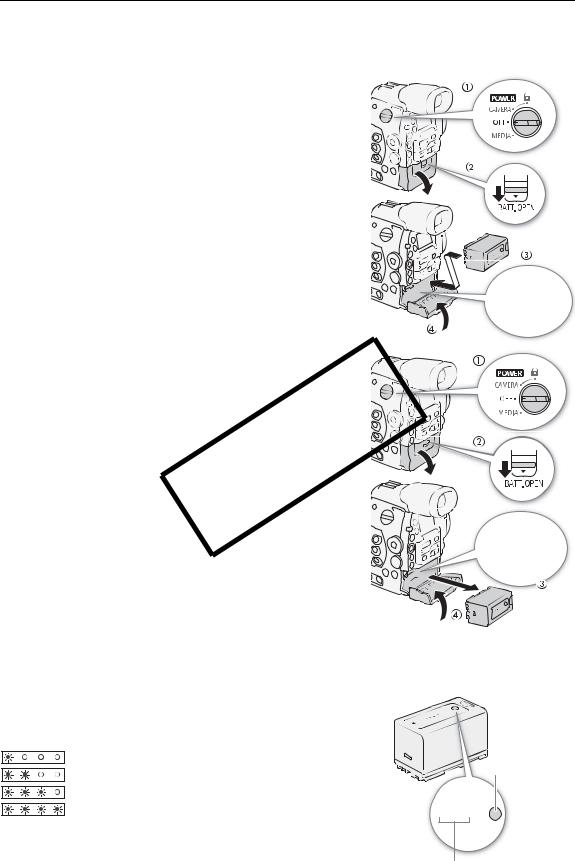
Preparing the Power Supply
Attaching the Battery Pack
1 |
Set the Qswitch to OFF. |
|
2 |
Slide the BATT. OPEN switch in the direction of the arrow and open |
|
24 |
|
the battery compartment cover. |
|
|
|
3 |
Insert the battery pack all the way into the compartment as shown |
|
|
|
in the illustration and press it gently toward the left until it clicks. |
4 |
Close the battery compartment cover. |
|
Removing the Battery Pack |
|
|
1 |
Set the Qswitch to OFF. |
COPY |
2 |
|
|
Slide the BATT. OPEN switch in the direction of the arrow and open |
||
|
the battery compartment cover. |
|
3 |
Holding down the RELEASE latch, slide the battery pack toward the |
|
|
right and then pull it out. |
|
4 |
Close the battery compartment cover. |
|
Checking the Remaining Battery Charge
When the camcorder is turned on, you can check the remaining battery charge by looking at any recording/ playback screen or the [Battery/Hour Meter] status screen (A169). When the camcorder is turned off, use one of the following methods to check the approximate remaining battery charge.
Press the CHECK button on the battery pack. An indicator will light for approximately 3 seconds and show the approximate remaining battery charge.
0-25%
26-50% |
CHECK button |
|
51-75%
76-100%
0 


 100%
100%
Battery charge indicator
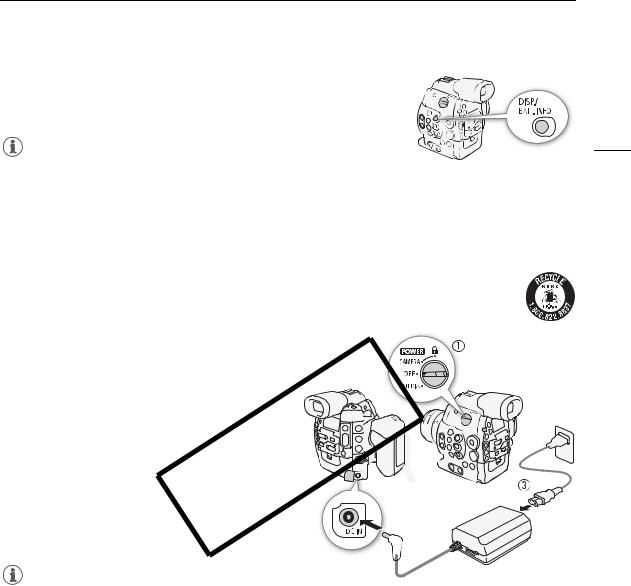
Preparing the Power Supply
Press the BATT. INFO button to display the remaining battery charge for 5 seconds. Depending on the battery life, the battery information may not be displayed.
25
NOTES
•The first time you use a battery pack, fully charge it and then use the
camcorder until the battery pack is completely exhausted. Doing so will ensure that the remaining recording time will be displayed accurately.
•Repeatedly charging and discharging the battery pack will eventually shorten its battery life. You can check the battery life on the [Battery/Hour Meter] status screen (A169) or the battery information screen (press the BATT. INFO button while the camcorder is turned off). Fully charging the battery pack and then discharging it will give you a more accurate reading.
• USA and Canada only: The Lithium ion/polymer battery that powers the product is recyclable. Please call 1-800-8-BATTERY for information on how to recycle this battery.
Using a Household Power Outlet
You can also power the camcorder directly from a power outlet using the supplied CA-940N Compact
Power Adapter.
COPY





2 Connect the compact power adapter’s DC plug to the DC IN terminal on the camcorder.
3 Connect the power cord to the compact power adapter and plug it into a power outlet.
 IMPORTANT
IMPORTANT
• Turn off the camcorder before connecting or disconnecting the compact power adapter.
DC IN
terminal
NOTES
•When using the camcorder with a household power
outlet, you can change the battery pack while the power is on.
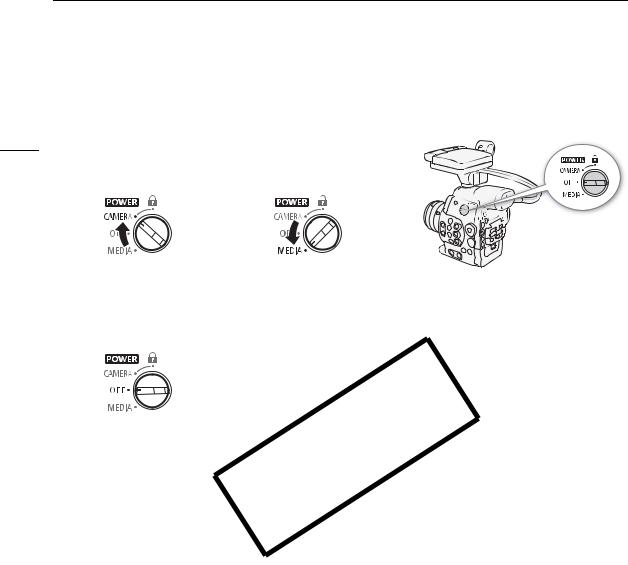
Preparing the Power Supply
Turning the Camcorder On and Off
The camcorder has two operating modes: CAMERA ( ) mode for making recordings and MEDIA (
) mode for making recordings and MEDIA (  ) mode for playing back recordings. Select the operating mode using the Qswitch.
) mode for playing back recordings. Select the operating mode using the Qswitch.
26 To turn on the camcorder
Set the Qswitch to CAMERA for  mode or MEDIA for
mode or MEDIA for  mode.
mode.
CAMERA mode |
MEDIA mode |
To turn off the camcorder
Set the Qswitch to OFF.
COPY
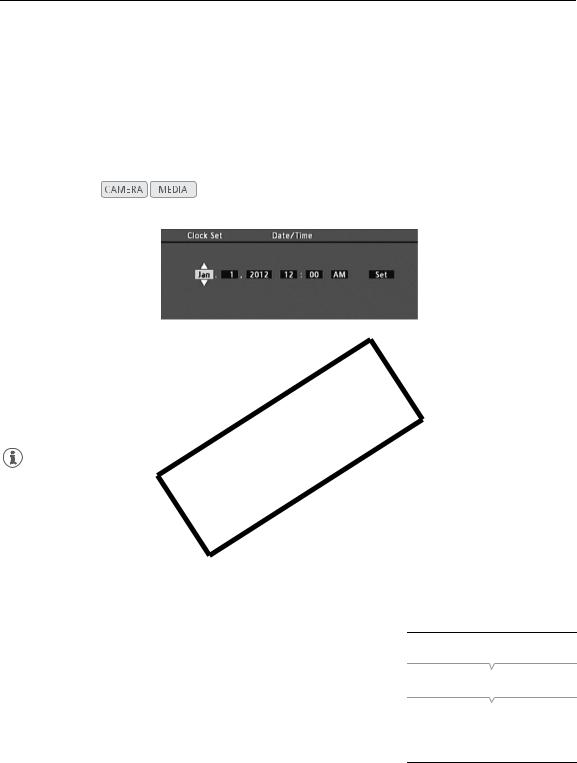
Date, Time and Language Settings
Date, Time and Language Settings |
|
|
Setting the Date and Time |
|
|
You will need to set the date and time of the camcorder before you can start using it. When the camcorder’s |
27 |
|
clock is not set, the [Date/Time] screen will appear automatically with the first field selected (month or day, |
||
|
||
depending on the country/region of purchase). |
|
|
Operating modes: |
|
1Push the joystick up/down or turn the SELECT dial to change the month/day then move (Ð) to the next field.
• To move to the next field you can also press SET (press the joystick itself or press the SET button).
•You can change the date formatCOPYand the clock format (12/24 hours) with the [wOther Functions] > [Set Clock] >[Date Format] setting.
•You can also change the date and time later on (not during the initial setup) with the [wOther Functions] > [Set Clock] >[Date/Time] setting.
•When the built-in rechargeable lithium battery is exhausted, the date and time setting may be lost. In such case, recharge the built-in lithium battery (A180) and set the time zone, date and time again.
•Using the optional GP-E1 GPS Receiver, you can have the camcorder adjust settings automatically according to the date/time information received from the GPS signal (A103).
Changing the Time Zone
Change the time zone to match the time zone of your location. The default setting is [UTC-05:00 New York] or [UTC+01:00 Central Europe], depending on the country/region of purchase. The time zones are based on Coordinated Universal Time (UTC).
Operating modes: 

[wOther Functions]
[Time Zone]
[UTC-05:00 New York]
or
[UTC+01:00 Central Europe]*
1 Press the MENU button.
2 Push the joystick up/down or turn the SELECT dial to select [wOther Functions].
3 Select [Time Zone] in a similar fashion.
4 Push the joystick up/down or turn the SELECT dial to change the time zone.
5 Press SET to set the time zone and then press the MENU button to close the menu.
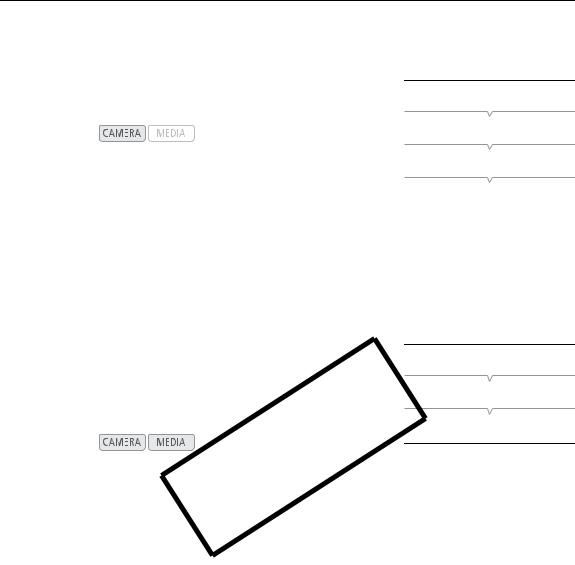
Date, Time and Language Settings
Displaying the Date and Time while Recording
[£LCD/VF Setup]
|
You can display the date and time on the screen. |
|
|
28 Operating modes: |
[Custom Display 2] |
||
|
|||
|
1 |
Press the MENU button. |
[Date/Time] |
|
|||
2 |
Push the joystick up/down or turn the SELECT dial to select |
[Off] |
|
|
|
[£LCD/VF Setup]. |
|
|
|
|
|
3 |
Select [Custom Display 2] and then [Date/Time] in a similar fashion. |
|
|
4 |
Push the joystick up/down or turn the SELECT dial to select the information to display. |
||
• Select [Off] to record without displaying the date and time.
5 Press SET and then press the MENU button to close the menu.
• The selected date/time display will appear at the bottom of the screen.
Changing the Language
The default language of the camcorder is English. You can change it to German, Spanish, French, Italian, Polish, Russian, Simplified Chinese, Korean or Japanese. Please note that some settings and screens will be displayed in English, regardless of the language setting.
1 |
Press the MENU button. |
2 |
Push the joystick up/down or turn the SELECT dial to select [wOther Functions]. |
3 |
Select [Language !] in a similar fashion. |
4 |
Push the joystick up/down or turn the SELECT dial to select a language. |
5 |
Press SET to change the languageCOPYand then press the MENU button to close the menu. |
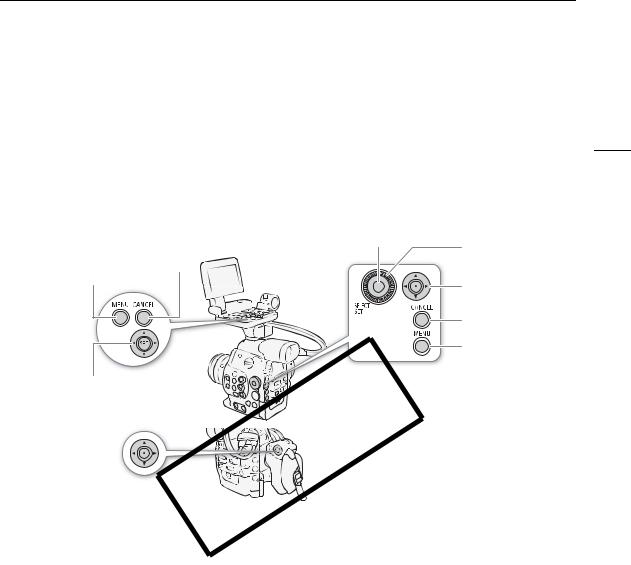
Using the Menus
Using the Menus
In  mode, many of the camcorder’s functions can be adjusted from the menu for general settings, which opens after pressing the MENU button. You can also register frequently used menu settings in a customized
mode, many of the camcorder’s functions can be adjusted from the menu for general settings, which opens after pressing the MENU button. You can also register frequently used menu settings in a customized
submenu (My Menu) for easy access. In  mode, press the MENU button to open the menu for general 29 settings or SET to open the clip menu for clip operations. For details about the available menu options and
mode, press the MENU button to open the menu for general 29 settings or SET to open the clip menu for clip operations. For details about the available menu options and
settings, refer to Menu Options (A155).
Operating modes: 

|
|
SET button |
|
|
SELECT dial |
|
CANCEL button |
|
MENU button |
|
Joystick |
|
|
|
|
|
CANCEL button |
|
|
MENU button |
Joystick |
|
MENU button |
|
Press to open the menu and then press again to |
|
|
|
|
|
COPY |
|
|
|
close the menu after adjusting desired settings. |
|
|
CANCEL button |
|
|
ress to return to the previous menu or to stop |
|
|
some operations that are in progress. |
|
|
SET button |
Joystick |
|
Note that while only the joystick on the monitor |
|
unit is labeled as “SET”, all three joysticks will |
|
Push the joystick to move the orange selection |
function as the SET button when pressed down. |
|
frame in the menu. Then, press the joystick itself |
|
|
or the SET button at the center of the SELE T |
SELECT dial |
|
dial to select the menu item indicated by the |
Turn the dial to move the orange selection frame |
|
orange selection frame. |
|
up or down in the menu. |
|
|
|
Selecting an Option from the Menu
The following is a step-by-step explanation of how to select an option from the menu. In the procedures throughout the rest of this manual, opening and closing the menu is assumed and not included in the procedure.
1 Press the MENU button.
•The menu opens with the orange selection frame indicating the menu item that was selected the previous time the menu was closed (unless the camcorder was turned off).
2 Push the joystick up/down or turn the SELECT dial to select the desired submenu. 3 Push the joystick right or press SET.
•The orange selection frame will appear on a menu item in the submenu.
•Press the CANCEL button, push the joystick left, or select [L] to return to the previous submenu.
4 Push the joystick up/down or turn the SELECT dial to select the desired menu item.
•If a submenu contains many menu items, a scroll bar will appear on the right side of the submenu indicating that you must scroll up or down to see other menu items.
•A Ðmark next to a menu item indicates another submenu. Repeat steps 3 and 4.
5 Push the joystick right or press SET.
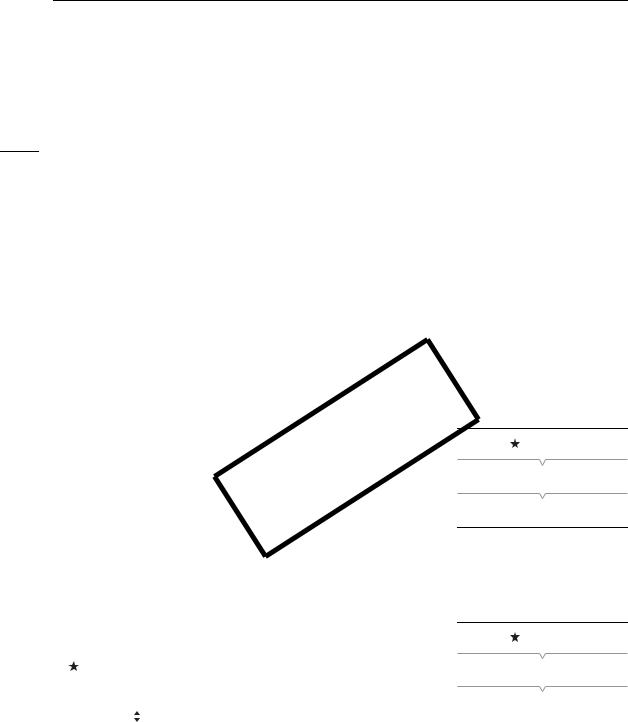
Using the Menus
•The orange selection frame will appear on a setting option.
•Press the CANCEL button to return to the previous submenu.
6 Push the joystick up/down or turn the SELECT dial to select the desired setting option and then
30press SET.
• Depending on the menu item, additional selections may be necessary.
7 Press the MENU button to close the menu.
 NOTES
NOTES
•Unavailable items may appear grayed out.
•Pressing the MENU button at any time closes the menu.
•When an optional RC-V100 Remote Controller is connected to the camcorder, you can use the remote controller’s up/down/left/right/SET buttons in the same way as the camcorder’s joystick.
•You can check the current settings on the status screens (A165).
Using the Customized Submenu (My Menu)
You can register up to 14 frequently used menu settings under the My Menu submenu for easy access. Furthermore, if you set an assignable button to [My Menu] (A111), you can press the button to access your registered menu settings even fasterCOPYand more easily.
Adding Menu Settings
[
1 Open the My Menu [Register] screen. [ My Menu] >[Edit] >[Register]
My Menu] >[Edit] >[Register]
• The menu will change to blue to indicate you are selecting menu settings to add to the My Menu submenu.
• Press the CANCEL button to cancel the operation and return to the regular menu.
2 Navigate the menus to find the menu setting you want to add and then press SET.
3Select [OK] and then press SET twice.
• The menu setting you registered will now appear under the My Menu submenu.
Rearranging Menu Settings |
[ My Menu] |
||
1 |
Open the My Menu [Move] screen. |
||
|
|||
|
[ My Menu] >[Edit] >[Move] |
[Edit] |
|
|
|
||
2 |
Push the joystick up/down or turn the SELECT dial to select the setting |
|
|
|
you want to move and then press SET. |
[Move] |
|
|
• An orange icon will appear next to the setting you selected to |
||
|
|
||
|
|
||
|
move. |
|
|
3 |
Push the joystick up/down or turn the SELECT dial to move the setting to the desired position and then press |
||
|
SET. |
|
|
